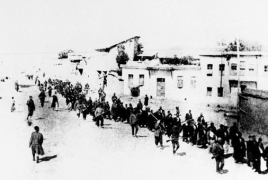
Photos depicting the Armenian Genocide and items from those says and other massacres will be displayed a haunting exhibit opening July 19 at the Illinois Holocaust Museum & Education Center in Skokie: “Stories of Survival: Object. Image. Memory,” Chicago Tribune reports.
The objects bear witness to the toll of genocide, a term coined to characterize the Holocaust but applicable to humanity’s seemingly never-ending campaigns to erase identity.
Which is the point of the exhibition: to remind that when one group of people is marked as different, alien, unwanted, less human, the result can be cataclysmic.
“Stories of Survival” imparts this lesson in intensely human terms. For rather than cite epic histories and copious figures, it brings us personal, closely held possessions: clothes, toys, photographs, letters, recipes and other seemingly ordinary items that the survivors of genocide — or their loved ones — managed to cling to.
Each item appears alongside a large photograph of it by Jim Lommasson, plus a handwritten description by a survivor or family member about the object’s meaning.
Conceived in anticipation of the museum’s 10th anniversary next year, “Stories of Survival” will serve as the institution’s first touring exhibition. From the outset, it was designed to explore not only the Holocaust but other genocides.
“Sadly, refugees and immigration has been in the news for far too long, when we have millions of people displaced worldwide,” says Susan Abrams, CEO of the Illinois Holocaust Museum.
“This is a universal story. And Chicago is a city and Illinois a state of immigrants. So we should all understand that and have empathy. This (exhibition) is a way for us to communicate that.
“We want people to be able to walk in somebody else’s shoes, make that discovery for themselves. Not to be told it — but to feel it and experience it.”It’s impossible not to feel the human cost of genocide when you look at these items, which were cherished by people who lost those close to them or who never survived themselves. Each object represents an eye-opening narrative.
“It was important for us to show people that these everyday items are imbued with such importance when they are the only things you have left,” says Shoshana Buchholz-Miller, the museum’s vice president of education and exhibitions.
“They’re not sentimental.”
All the Holocaust-related items were drawn from the museum’s collection, but because the museum does not gather materials from other genocides, staff needed to look elsewhere for the rest.
“We contacted the different communities through longstanding partnerships we’ve had because of programming and outreach” to other institutions, says Arielle Weininger, chief curator of collections and exhibitions.
“They sort of self-selected who would participate, and we asked them to offer up whatever was appropriate.”
Thus the exhibition encompasses genocides from Armenia, Bosnia and Herzegovina, Cambodia, the Holocaust, Iraq, Rwanda, South Sudan and Syria.
To look deeper into the stories behind some of the items, we visited four of the survivors whose possessions are included in the exhibition and asked each the same questions: What happened? Why did you save these objects? Why is there genocide? How has this experience changed you?
Their testimonies (edited here for clarity and space) illuminate their heroism, not only for what they endured but for their willingness to share their histories with a world that doesn’t always want to listen.

